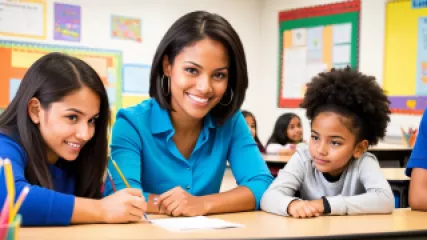My Journey in Educational Psychology: Discovering the Power of Empathetic Teaching
My Journey in Educational Psychology: Discovering the Power of Empathetic Teaching
As a young student, I never imagined that my fascination with the human mind and its intricacies would lead me down the path of educational psychology. But that is precisely the journey I embarked on, and it has been a transformative experience that has shaped my life in ways I could never have foreseen.
My name is Mason Lewis, and this is the story of how I discovered the power of empathetic teaching and the profound impact it can have on the lives of students.
The Spark that Ignited My Passion
It all started when I enrolled in an introductory psychology course during my first year of college. I was immediately captivated by the complex mechanisms that govern human behavior, learning, and cognition. The more I delved into the field, the more I realized that my true passion lay not just in the general study of psychology, but in the specific realm of educational psychology.
What fascinated me most was the idea that the way we approach teaching and learning could have such a profound impact on the success and well-being of students. I was intrigued by the notion that by understanding the cognitive, emotional, and social factors that influence the educational process, we could create more effective and empathetic learning environments.
Exploring the Intricacies of Educational Psychology
As I progressed through my studies, I immersed myself in the rich tapestry of educational psychology. I delved into theories of cognitive development, learning styles, and motivation, eager to understand how these concepts could be translated into practical, student-centered teaching strategies.
One pivotal moment came during a field placement in a local elementary school. Observing the interactions between teachers and students, I witnessed firsthand the transformative power of empathetic teaching. I saw how a teacher's ability to connect with each student on a personal level, to understand their unique needs and challenges, could spark a flame of enthusiasm and engagement that would otherwise have remained dormant.
It was in these moments that I realized the true essence of educational psychology – it was not just about imparting knowledge, but about fostering an environment where students felt valued, understood, and empowered to reach their full potential.
Embracing the Challenges and Rewards of Empathetic Teaching
As I continued my studies and began to explore the various facets of educational psychology, I came to understand that the path of the empathetic teacher was not without its challenges. Navigating the complexities of diverse student populations, adapting to different learning styles, and addressing the unique social and emotional needs of each individual required a deep well of patience, creativity, and a genuine passion for the craft of teaching.
Yet, with each obstacle I encountered, I found myself becoming more resilient, more adaptable, and more committed to the cause. The rewards of seeing a student's eyes light up with understanding, of witnessing the transformative power of personalized learning, and of playing a role in shaping the next generation of thinkers and leaders, fueled my determination to become the best educational psychologist I could be.
Embracing the Diversity of Educational Psychology
As I delved deeper into the field of educational psychology, I discovered the incredible breadth and diversity of its applications. From early childhood education to adult learning, from special needs programs to gifted and talented initiatives, the principles of empathetic teaching could be adapted and applied to a wide range of educational settings.
I was particularly drawn to the role of educational psychology in supporting students with unique challenges, such as those with learning disabilities, behavioral disorders, or mental health concerns. I saw firsthand how a deep understanding of these issues, coupled with a compassionate and individualized approach, could unlock the doors to academic success and personal growth for students who had previously struggled to find their footing in traditional educational environments.
Through my coursework and hands-on experiences, I developed a keen appreciation for the multifaceted nature of educational psychology, and the way it could be woven into the fabric of education to create truly transformative learning experiences.
Forging Connections and Collaborations
One of the most rewarding aspects of my journey in educational psychology has been the opportunity to collaborate with a diverse array of professionals, from teachers and administrators to counselors and social workers. By sharing knowledge, exchanging ideas, and working together to address the evolving needs of students, I have been able to expand my own understanding and contribute to the broader efforts to improve educational outcomes.
Through these collaborative efforts, I have gained a deeper appreciation for the interdisciplinary nature of educational psychology, and the way it intersects with fields such as child development, special education, and mental health. By fostering these connections, I have been able to develop a more holistic and comprehensive approach to supporting the academic, social, and emotional well-being of the students I work with.
The Transformative Power of Empathetic Teaching
As I reflect on my journey in educational psychology, I am struck by the profound impact that empathetic teaching can have on the lives of students. I have witnessed firsthand how a teacher's ability to connect with their students, to understand their unique needs and challenges, and to create learning environments that are nurturing, supportive, and responsive, can unlock a world of possibilities for young minds.
Whether it was helping a struggling student overcome their fear of mathematics, guiding a talented artist to discover their true creative potential, or supporting a student with a disability to overcome social and academic barriers, the power of empathetic teaching has been a constant source of inspiration and motivation for me.
And it is not just the students who are transformed by this approach. I too have been profoundly impacted by my experiences in educational psychology, as I have grown to become a more empathetic, adaptable, and effective educator, constantly striving to bridge the gap between theory and practice, and to create learning environments that are truly inclusive and empowering.
Continuing the Journey and Sharing the Insights
As I look to the future, I am excited to continue my journey in educational psychology, to deepen my understanding of the field, and to explore new and innovative ways to support the educational and personal growth of students. Whether it is through research, teaching, or direct work with students and families, my goal is to be a tireless advocate for empathetic teaching and to contribute to the ongoing efforts to transform the educational landscape.
But my journey is not just my own. I am passionate about sharing the insights and lessons I have learned with others, whether they are aspiring educational psychologists, seasoned teachers, or simply individuals who are interested in the power of empathetic teaching. Through workshops, public speaking engagements, and the creation of educational resources, I hope to inspire and empower others to embrace the transformative potential of this approach, and to join me in the pursuit of creating a more equitable and inclusive educational system.
In the end, my journey in educational psychology has been a profound and deeply fulfilling experience, one that has shaped me not just as a professional, but as a person. It is my hope that by sharing my story, I can inspire others to embark on their own journeys of discovery, and to unlock the power of empathetic teaching in their own lives and the lives of the students they serve.
Embracing Educational Psychology as a Pathway to Empowerment
As I reflect on my journey in educational psychology, I am struck by the profound ways in which this field has empowered me, both as a practitioner and as an individual. Through my studies and experiences, I have gained a deep understanding of the cognitive, emotional, and social factors that shape the educational experiences of students, and I have developed a toolbox of strategies and techniques to support their growth and success.
But more than just a set of professional skills, educational psychology has also transformed my personal outlook and approach to life. By studying the principles of empathetic teaching, I have learned to be more attuned to the needs and perspectives of others, to approach challenges with greater flexibility and creativity, and to find joy and fulfillment in the process of learning and growth, both for myself and for those around me.
As I continue to navigate the ever-evolving landscape of education, I am driven by a sense of purpose and a deep commitment to making a positive difference in the lives of students. Whether I am working one-on-one with a struggling learner, collaborating with a team of educators to develop innovative curricula, or advocating for systemic change in the educational system, my work is fueled by a profound belief in the power of empathetic teaching to transform lives and unlock human potential.
And it is this belief, this passion, that I hope to share with others through my journey in educational psychology. By sharing my own experiences, insights, and lessons learned, I aim to inspire and empower others to embrace the field of educational psychology as a pathway to personal and professional growth, and to join me in the pursuit of creating a more equitable, inclusive, and empowering educational landscape for all.
Conclusion: A Lifelong Commitment to Empathetic Teaching
As I look back on my journey in educational psychology, I am filled with a profound sense of gratitude and wonder. What began as a passing interest in the workings of the human mind has blossomed into a deep and abiding passion for the power of empathetic teaching to transform lives and communities.
Through the course of my studies and experiences, I have come to understand that educational psychology is not just a field of academic inquiry, but a calling – a deeply rewarding and meaningful way of engaging with the world around me, of supporting the growth and development of others, and of contributing to the creation of a more just and equitable society.
As I look to the future, I am filled with a renewed sense of purpose and determination. I am committed to continuing my research, my teaching, and my direct work with students and families, always striving to deepen my understanding of the intricacies of educational psychology and to find new and innovative ways to apply its principles in service of the greater good.
And it is with this sense of purpose and passion that I invite others to join me on this journey. Whether you are an aspiring educational psychologist, a seasoned teacher, or simply someone who is interested in the power of empathetic teaching to transform lives, I encourage you to embrace this field as a pathway to personal and professional growth, and to contribute your own unique perspectives and experiences to the ongoing efforts to create a more empowered and empowering educational landscape.
Together, we can unlock the full potential of educational psychology, and in doing so, we can transform the lives of students, educators, and communities around the world. It is a journey that is both deeply personal and profoundly impactful, and one that I am honored to be a part of.






